The Complete Guide to Knitting Crescent Shawls
Crescent shawls have been very popular shawl shapes for a few years and don’t seem to lose any popularity among knitters all over the world so far. Guess it’s time to devote some time to explain how to knitting crescent shawls in detail: how do they look like, and how can they be constructed?
Table of Contents
- Day 1: An Introduction to Crescent Shawls (this post)
- Day 2: Short Row Crescent Shawls
- Day 3: Short Row Calculations Made Easy
- Day 4: Crescent Shawls Worked Sideways
- Day 5: Winged Crescent Shawls
- Day 6: Austrian Crescents
- Day 7: Introducing Stitch Patterns into Crescent Shawls
- Day 8: Size & Shape Adjustments
- Day 9: Summary & Further Reading (Jan 14, 2020)
PS. This series is available in book form, too: The Complete Guide to Crescent Shawls
What The Heck Are Crescents?
If you ask an astronomer, you might get the answer that a crescent is the shape of the lit side of a spherical body (most notably the Moon) that appears to be less than half illuminated by the Sun as seen by the viewer.
In other words: Crescents (and crescent shawls!) looks similar to the moon in the picture below.

Other popular crescent shaped items are Croisssants, for instance. Looks like we eat crescents for breakfast regularly here in South Germany. Laugenkipferl – Yum!

But we’re talking about knitted shawls, not food or the moon. So let’s get back on topic:
What Are Crescent Shawls?
Crescent shawls are shawls shaped like crescents – no really surprise here I guess. A few years back, lots of shawl knitters were fed up with knitting triangle shawls and stoles all the time, and many did not want to attempt knitting more complicated shapes like Faroese shawls, for example. And then Knitty.com published their spring/summer issue 2010 featuring the Annis shawl by Susanna IC:
“I love traditional triangular shawls, but sometimes they are difficult to keep in place without a pin.
I have been experimenting with different shapes that could be simply tied like a scarf or have longer ends that would drape gracefully around the shoulders. Annis’ distinctive crescent shape lends itself to numerous ways of tying and draping, making it a versatile accessory. ” [knitty.com]
And people just welcomed this – at that time – new shawl shape so very warmly. Yay, a new shawl shape!
Since then, lots of patterns for crescent shawls have been published and I have been no exception. A very popular example is my Priscilla shawl pattern shown below.
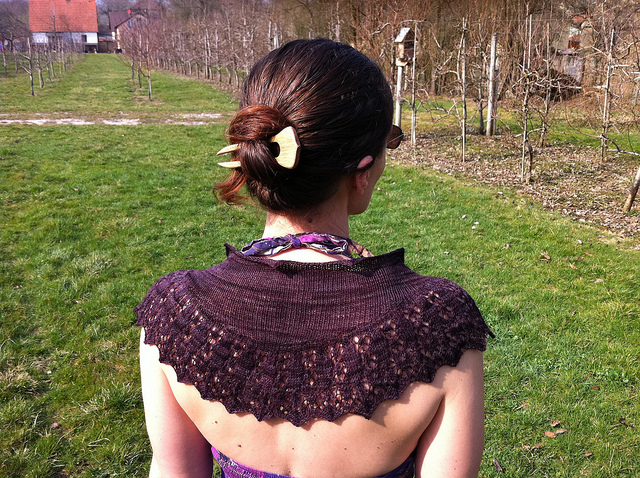
Other examples are Elisabeth…
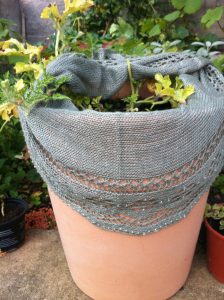
… and Phoebe.
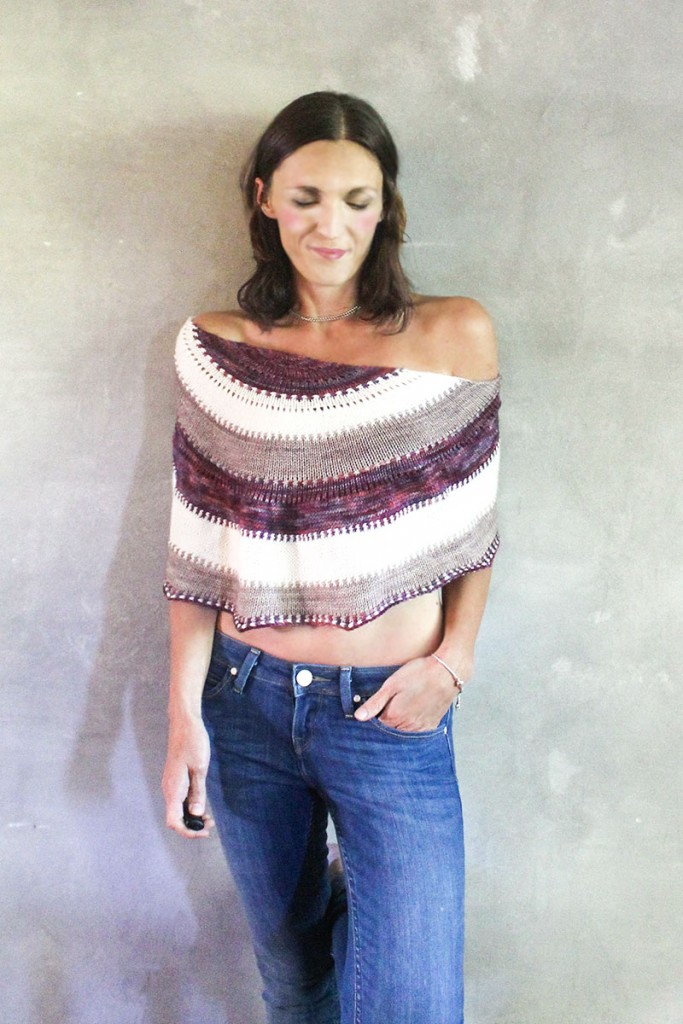
But wait … crescent shawls always use short rows, don’t they?
After the publication of the Annis shawl in Knitty magazine there were three types of people: first, those who always felt comfortable with this particular technique and didn’t mind at all. Second, those who had been scared away by short rows but gave it a try after this pattern came out finally.
Third, all those who loved the shape and its versatility but just couldn’t imagine do knit a short row ever. Every. Short rows? Just a no-go!
There’s good news: you won’t have to knit a single short row to achieve a crescent shawl shape. There’s more than one way to do it!
Crescent Shawl Construction Methods
Short Row Crescent Shawls
Short row crescent shawls consist of a triangle shaped by short rows and an edging. They can be worked top-down as well as bottom-up. The final crescent shape is achieved by blocking.
The figure below shows a crescent shawl shaped by short rows before (yellow) and after (dashed line) blocking.
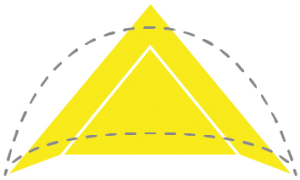
Details on how to work and design short row crescent shawls can be found in part two of this article series.
Crescent Shawls Worked Sideways
Crescent shawls can be worked sideways, too: start with casting on a few stitches and work a triangle with increases on one side only until you reach the desired width. Work straight (without any increases or decreases) until your shawl is of desired length minus the length of the first triangle section worked, then decrease again – on the very same side you increased your stitches at first like shown in the schematic below (knitting direction in the schematic is left to right).
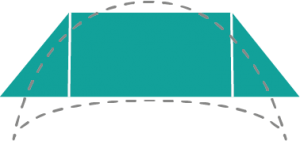
Same as for crescent shawls shaped using short rows, the desired crescent shape when working sideways is achieved by blocking!
Crescent shawls worked sideways are covered on day 4 of this course.
Winged Circular Crescent Shawls
Winged circular crescent shawls – I call them winged crescent shawls – are my invention. I designed this method of creating crescent shawl shapes after being asked a thousand times how to work crescent shawls without using short rows and being fed up with working them sideways: I just combined a half circle with two wings as used in winged triangle shawls.
A schematic is show below. As for the construction methods mentioned above, this shawl shape is finalized by blocking too!
 How to create winged crescents in detail – including a pattern template for them – and how to calculate short row numbers & turning points, when to start the wings in winged crescents and how to calculate crescent shawl design numbers in general is covered in my article How to Knit Winged Crescent Shawls.
How to create winged crescents in detail – including a pattern template for them – and how to calculate short row numbers & turning points, when to start the wings in winged crescents and how to calculate crescent shawl design numbers in general is covered in my article How to Knit Winged Crescent Shawls.
Other shaping methods include the Austrian crescent (also my invention) and others. Details about them will be added here in the next days, so stay tuned!


Pingback: Crescent Shawls: Size and Shape Adjustments - knitting.today
Pingback: Short Row Calculations Made Easy - knitting.today
Pingback: How To Knit Winged Crescent Shawls: The Ultimate Tutorial - knitting.today
I remember the loss of your husband – so sad and difficult to ‘get on with your life’. Perhaps next holiday season will be a ‘happier one’.
Congrats on being able to work your clinicals — you have work long and hard to get here. I know you will continue to work hard to become a practicing doctor. Best of luck. and happy you have completed your studies so far.